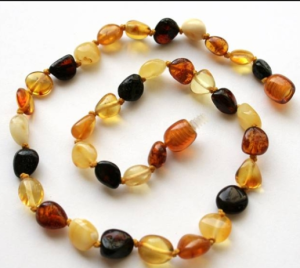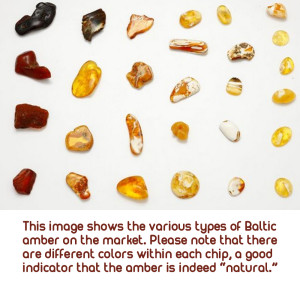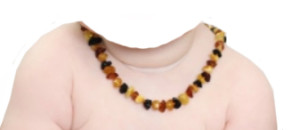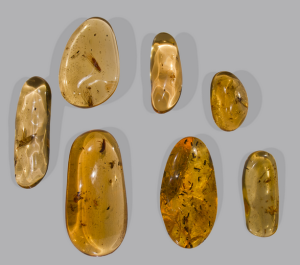I am re-printing material here I developed in connection with another project. You may be approached for an opinion on the necklaces and/or you may be asked to manufacture one. I’m also posting the following as a downloadable pdf if you wish to keep a copy for reference.
I believe the issue is an important one and one which our community should be knowledgeable about. The following is a little long, but I hope you’ll at least skim through it.
Rethinking Natural Baltic Amber Teething Necklaces for Infants and Toddlers
 I recently became aware of the apparently growing practice of parents providing infants and toddlers with amber necklaces for help with teething discomfort. I discovered this while researching another product for Unicorn Station, a company with which I am associated – and in the spirit of full disclosure, Unicorn Station offers a teething necklace.
I recently became aware of the apparently growing practice of parents providing infants and toddlers with amber necklaces for help with teething discomfort. I discovered this while researching another product for Unicorn Station, a company with which I am associated – and in the spirit of full disclosure, Unicorn Station offers a teething necklace.
I wish to emphasize that the following is my own opinion, informed by nearly 30 years in the gem trade. I intend for this to offer parents and gift-buyers solid advice, and hope it will add value to your decision whether or not to buy an amber teething necklace for your infant or toddler.
Fleury Sommers
Is it Really Amber?
 I recently became aware of the volume of amber chips being sold on Amazon — and I assume other platforms — as teething necklaces for babies. The chips are described as anti-inflammatory and as providing a “natural remedy” for drooling and teething pain.
I recently became aware of the volume of amber chips being sold on Amazon — and I assume other platforms — as teething necklaces for babies. The chips are described as anti-inflammatory and as providing a “natural remedy” for drooling and teething pain.
Most of the marketers also make some kind of claim about the necklaces being made of the highest quality certified Baltic amber.
As someone who loves amber, studies it and collects it, I was stunned just as I was a number of years ago, when as a young gemologist, I overheard a dealer tell a client that the “cherry” amber the client was considering buying was natural.
Whether these sellers are deliberating distorting the truth or are as credulous as their buyers, they do a disservice to the gem industry. In my opinion, they are selling a product that in all probability is mislabeled, but one that could pose a real danger to teething infants.
First, it’s important to understand that even among professionals amber is one of the least understood of all the gemstones. That’s because it can be imitated so easily and, unlike diamonds or colored gemstones, there is no consistent demand for it. That is, demand goes up or down depending upon various marketplace trends or fads. As a result, amber is not studied as carefully by professionals as other stones which are more consistently in demand.
So assessing sellers’ claims is a little imprecise, but it can be done, usually with destructive tests. My objective here isn’t to describe those tests, which can be found on-line and which are destructive to the amber being tested. My objective is to give you a glimpse of how gemologists think about gemstones and whether they are as described by sellers.
Let’s begin with the easiest and perhaps most important clue first: price.
Most of the teething necklaces sold on Amazon are priced between fourteen and twenty dollars and are accompanied by some sort of “certification” from sellers. Even if you know nothing else about amber except that it is considered an important organic gemstone, do these prices make sense? Of course they don’t.
Now, consider that genuine natural Baltic amber chips sell on the wholesale gem market for at least double the retail prices asked on Amazon.
That fact in itself does not inspire confidence that customers are getting the “genuine natural Baltic amber chips” described in the promotional materials. So, of course, the question is what are they getting?
There are other clues. But, first a little background.
At the lower end of the amber market, there are three major types of amber imitations and/or synthetics.
First, a colorized plastic is heated and pressed or tumbled into various forms including beads. I own a “cherry” amber necklace from the 1920s. The necklace is interesting. Some might consider it beautiful. But it’s not amber because cherry amber does not exist in nature. It’s a polymer that has been pressed into beads. Plastic is the easiest material to use in imitating amber. But remember, amber is a resin, not a polymer. Plastic also presents with a uniform color, unlike the different colors you will find in a single piece of amber.
Second, manufacturers take the shavings and other leftovers from the tumbling and polishing process, heat them to a high temperature, and form them into beads, chips and other forms. This is called reconstituted amber. Reconstituted amber might or might not contain materials such as oils and other resins. The processes used and the materials in them are kept secret for obvious competitive reasons. The image below is of reconstituted amber. Note the uniformity in color. Also, note the “spangles” in the amber. These are gas bubbles that have burst in the heating process, but which mimic the inclusions for which amber is famous.
Third, copal is a young or semi-fossilized amber from the Dominican Republic and elsewhere. Copal is young only in comparison with genuine amber which is 40 million years old. Copal can range in age between fifty and 1.6 million years. In addition, copal is the product of different trees. So, copal is similar to, but is not amber.
To the untrained eye, copal can look very much like amber as this image from Wikipedia demonstrates.
Without resorting to destructive tests, one clue is the number of inclusions in the copal which will not present in amber at the same price points. Another is the fact that the surface of copal will be subject to small cracks as it gets older.
So, uniform color, star bursts or spangles in the beads and an abundance of inclusions suggest that the material is not amber. Couple this with the price points described earlier and then compare them with the wholesale costs of genuine natural Baltic amber chips, and I think most people would conclude that most of the products offered as “genuine Baltic amber teething necklaces” are either plastic imitations, reconstituted amber or copal. Now, please remember that nothing is wrong with imitations, reconstituted gemstones or copal as long as those facts are disclosed to the buyer.
If you conclude as I do that in this context the buyer is at risk of purchasing something other than that which is being described by the seller, you must also conclude that you don’t want your infant or toddler chewing these products. You need to know what going into your baby’s mouth.
It’s important to say that if you find the necklaces beautiful, by all means buy and wear them. You’re not going to chew on them.
In the next section, I’ll review the health claims made by these sellers that I believe should be viewed with deep skepticism.
You’re Kidding, Right? Health Claims Made for Amber
Gemstones have been associated with myth and legend since mankind began to adorn itself. Early Chinese myths told of pearls falling from the sky when dragons fought. Pearls are said to offer the power of love, money, protection and luck. Hematite was worn by Roman soldiers who associated it with Mars, the god of war. They believed hematite would protect them in battle. Lapis Lazuli, a gemstone often associated with royalty, is believed to strengthen awareness, increase creativity and cure insomnia.
Do soldiers believe hematite shields them from danger? No, of course not. Do we really believe lapis cures insomnia? I don’t. Do we believe that pearls bring us happiness, money, protection from danger and good luck? No, but it’s fun to know these associations. They increase our appreciation of the gemstones and their histories.
Through the centuries, amber has been used primarily as adornment. It has also been used for healing by societies that relied on primitive medicine. The Romans, for example, used amber to protect from madness. They ground it into powder for use in curing throat, ear, eye and stomach disease. In the Middle Ages, it was used to treat jaundice and in alchemy experiments. In tsarist Russia it was used as a protection for nannies and babies.
All of this – and much more – would be simply fun and interesting information if amber advocates were not using this history to promote the notion that amber’s “healing” properties actually reduce mild pain, including the pain involved in teething.
The supposed “science” cited to support healing claims can sound serious enough to be credible. Baltic amber contains succinic acid. The theory advanced is that amber is heated via contact with the baby, releasing the acid from the beads into baby’s skin. This in turn has an analgesic effect that reduces the pain of teething.
There are a few things wrong with this:
First, it is extremely unlikely that your baby’s skin is warm enough to cause amber to release succinic acid into his or her body. Remember that Baltic amber becomes softer at about 150 degrees centigrade or 300 degrees Fahrenheit, and melts at 300 degrees centigrade and 570 degree Fahrenheit.
Second, as I described, I do not believe that the majority of necklaces sold as natural Baltic amber are indeed Baltic amber or even natural. This means that if your amber necklace is releasing some substance onto your baby’s skin, you can’t be sure what it is. But remember, even if the necklace is natural Baltic Amber and in the extremely unlikely event your baby is hot enough to cause the amber to sweat succinic acid, you still don’t know how much acid your baby is absorbing. Does this sound like good or smart parenting?
Finally, there is no evidence that succinic acid is effective as an anti-inflammatory or general analgesic. There are no studies small or large in any scientific publications that support the claims that succinic acid, via amber, is a pain remedy.
Next, more safety issues.
Teether Guidelines from the Consumer Product Safety Commission
![]() In the U.S., the Consumer Product Safety Commission is responsible for monitoring the safety of rattles, squeeze toys and teethers. The commission also issues regulations and safety tips concerning the usage of these products.
In the U.S., the Consumer Product Safety Commission is responsible for monitoring the safety of rattles, squeeze toys and teethers. The commission also issues regulations and safety tips concerning the usage of these products.
Like many safety tips, from government and elsewhere, these guidelines are mostly a matter of common sense. But in this context, they’re worth repeating since amber teething necklaces violate two of the CPSC’s three applicable safety guidelines for pacifiers and teethers.
First, the commission advises consumers to “check all rattles, squeeze toys and teethers for small ends that could extend into the back of the baby’s mouth.” If the item is too small, the commission suggests throwing it out.
The commission posts the template reproduced below and advises that “anything that fits inside this template is a choking hazard.” Amber chips are only a few millimeters in size. Entire necklaces can even fit into this template.
 The Commission also advises that “Teethers, like pacifiers, should never be fastened around a baby’s neck.”
The Commission also advises that “Teethers, like pacifiers, should never be fastened around a baby’s neck.”
Teethers fastened around a baby’s neck present a manifest choking hazard, yet there are a multitude of images online with babies wearing these necklaces. I’ve removed the baby’s face from the image below, but it is an example of the type of image you’ll see.
 It is appalling to me that retailers suggest directly or by implication that a baby should wear anything around the neck.
It is appalling to me that retailers suggest directly or by implication that a baby should wear anything around the neck.
I do believe that the vast majority of these sellers offer the product with no ill intent. I also believe they are naive in the extreme if they actually believe the product claims they’re making.
Finally, I’d like to add a word on the manufacture of these necklaces. Marketers will tell you that knots placed between chips reduce the possibility that baby will swallow a chip if the necklace breaks. The knots can prevent all the beads downstream from the point of the break – except the one set free by the break — from scattering. Of course, and with respect, they don’t mention the possibility that baby will put that one chip in his or her mouth.
But there is more. As the name suggests, “chips” are small fragments of a gemstone or imitation gemstone. The drillhole through which the chips are strung therefore is proportionately larger than in other, larger gemstones. The very size of the drillhole increases the possibility of the chip breaking and of chips being swallowed by baby. These chips can have sharp edges and as I’ve mentioned, in all probability we don’t know exactly what the material is.
In sum, we don’t know exactly what is being sold as “Natural Baltic Amber.” The so-called healing properties of Baltic Amber are based on ancient reports of primitive medical practices, and on unrealistic and illogical temperature and chemical-release scenarios. And, finally, the usage of amber teething necklaces violates safety guidelines from the Consumer Product Safety Commission.
As a responsible parent, do you really want to take that risk?



